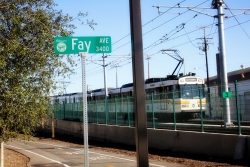The first phase of the Exposition Transit Corridor Light Rail Line has been well-received by a large segment of light rail advocates, county transportation officials and Culver City elected leaders. Many of the city’s residents have said they also enjoy using the light rail line to visit downtown Los Angeles and beyond and the train has been touted as a necessary and eventual cost-effective approach to reducing traffic congestion as well as pollutants from automobiles.
But homeowners who live near the train tracks near National and Washington boulevards tell a different tale. Nearly six months after the News interviewed several east Culver City residents who complained about the noise emanating from the tracks, many still feel dismayed that what they feel are the biggest impediments to restoring a degree of how their lives where before Expo came to town have not been resolved.
Alana Shiparo says the train’s cars have ceased blowing their whistles when they arrive in Culver City, but that is the only problem that she can point to that has been rectified since light railed came to the “Heart of Screenland” over a year ago.
“We have been promised a lot of things that they haven’t done yet,” she said.
Don Gilbert, who lives near the train tracks, concurs with his neighbor. “I haven’t seen any major improvements,” said Gilbert.
The Expo Line, as the light rail is know, has been deemed a success by Metro and by virtue of the spike in people taking public transportation last year. Mass transit advocates agree that while it is in its nascent stages, the light rail line has the possibility of drastically reducing car traffic on the perennially congested Westside.
The first light rail project designed to serve the Westside, the Expo Line is slated to continue its journey to Santa Monica, where it is expected to end four blocks from the beach on 2016.
East Culver City residents have protested multiple times to City Hall and last year the city retained Mestre Greve Associates for acoustical engineering service to assist in the review of the Expo Project.
City officials say Metro has determined that some of the reasons for the noise that residents have complained about are due to structural problems. “There are some gaps in Expo project sounds walls on the perimeter, between bike path and the residences and sound panels on the aerial structure, between Caroline Avenue and Wesley Street. These gaps occur at various locations in both the walls and panels,” explained Public Works Senior Management Analyst John Rivera.
“The Expo Construction Authority has directed the contractor to close these gaps. Expo has advised the city that the work should be completed within the next couple of weeks.”
The transit authority has also taken additional steps to reduce the sounds that are disturbing the homeowners.
“Expo has completed the installation of caulking the gaps between the sound walls and the foundation walls, and closing the gaps at the corners of the sound walls we’ve identified on the perimeter sound wall,” Rivera said. “They have also installed caulking in the gaps between the sound panels MSE wall on the aerial structure, and attempted to fill the larger vertical gaps between panels.”
Sound measurements will not be done until any necessary work is completed, Rivera added.
One of Gilbert’s chief grievances is the noises that occur when the train turns around at the end of the line in Culver City and heads back into Los Angeles. “What surprises me is that nothing was done on Sherbourne (Drive) before the tracks were built,” he said, referring to one of the streets where the crossover takes place.
According to Rivera, that has been remedied.
In November, Expo replaced some components of the crossover equipment between Sherbourne and Cattaraugus Avenue. “We and Metro verified some intermittent sound issues and the city is waiting to hear the outcome of the Metro review and an inspection by Expo’s equipment supplier,” Rivera added.
Shiparo said by removing a natural noise absorber during construction of the light rail line, transportation authorities permitted the current situation to manifest. “They removed an oleander tree (near her home) that served as a natural buffer,” she said.
Gilbert gave Rivera credit for staying in contact with the residents who have been affected by the train noises. “He has tried to keep us apprised of what’s going on,” he said.
Another unwelcome sight that residents interviewed say has become common is a plethora of trash along the bicycle path, including discarded prophylactics.
“They’re everywhere,”
Shiparo said.
Councilman Jim Clarke is the only elected official that the homeowners say has shown any interest in resolving their problems.
City Councilman MichaélO’Leary lives in east Culver City.
While the improvements are welcome, homeowners who live near the light rail tracks continue to find it difficult to see only the potential benefits of the Expo Line’s arrival in Culver City.
“It’s a tradeoff because (the train) impacts the quality of life of the neighborhood,” said Gilbert.
“The only sound wall that seems to be working is between us and Metro,” Shiparo concluded.













